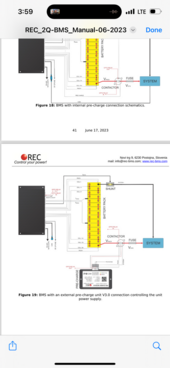I have not read the entire thread. Apologies. My question is, do we know, did the arc start a fire that spread to the batteries? Or did incoming power overload the batteries somehow, and then the battery cells actually initiated the fire? I ask because I travel in a yurt, therefore I have my LiFePo4 cells inside my yurt with me. I cannot have an outbuilding for various reasons. Since the fire started at night, the solar was obviously not feeding excessive power into the system. This fault must have come from the battery outputting excessive power, for some reason, or from an incoming power source feeding massive amps into the system? I have four 12v packs of LiFePo4 cells (Lf280k). Each pack is individually mega-fused (125 amps) before connecting through a Lynx PowerIn bus. Each pack is BMS limited to 100 amps. I am curious as to how large of an arc can be initiated by 100 amps @ 12v, and whether it could arc across that fuse gap? I cannot conceive of any situation that could cause that battery to output enough power to jump such a gap, and since I have no incoming power besides 60 amps from my charge controller, I cannot see any chance of incoming power causing such a situation, either. But I want to try to understand what caused the situation of this fire, just in case I've overlooked something.
One big difference between your setup and the OP is he was working at 48v verse 12v.
Doing the math -
each battery has internal resistance of 2.72mΩ before a short cell.
Put all of those in parallel and you get 0.388mΩ
Now assume the batteries are at 55.2v (16 * 3.45)
If we just do ohms law and delete one cell from one battery and figure what is left .... Either the figure is 750amps from the other 6 strings or somewhere in the neighborhood of 9000amps for an instant.
If it is 9000amps there is really nothing going to stop instant combustion.
Now - there are some assmptions here
But this brings to mind recent discussion of where to put fuses in parallel configuration .... i.e. at the bus bar or the battery or both.
In this case he had quit long cables and the fuse closer the bus bar
At any rate if the fuse blew at 0.1 seconds and the wire was 2/0 welding wire and 2 meters long - this makes the wire temp 94c... not to bad, hot but not bad.
Now - add in a megafuse (0.0004ohms) - two bolt on connections of 0.0004 ohms.
This recalculates as 119c or 246f
NOW - the mega fuse 58v data sheet says at 600% of rated amps it will blow between 0.1 sec and 1.0 sec.
Recalculate with time of 1.0 sec
The wire and fuse will be at 966c or 1769f
So the wire was probably someplace in between those numbers
and the fuse plastic if a form of ABS which ignites 349c, if it is a form of PET it ignites around 275c
Wire rated at 105c presumably.
I think this brings us back to the fuse as the hotest point in the wire and the fuse is the fuse itself.
I think I agree with the fire investigator now. The ultimate cause could have been just an out of balance cell verse an actual vent/short.



